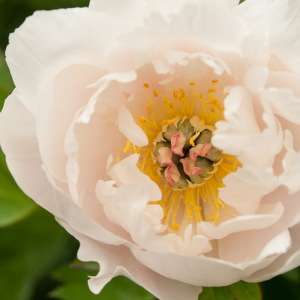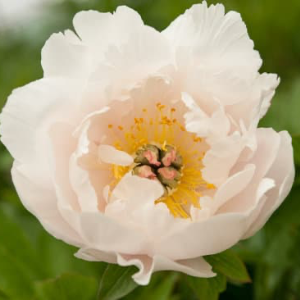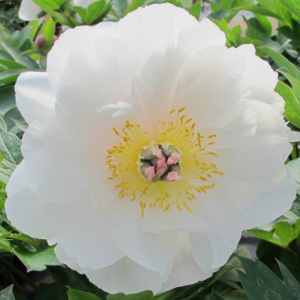Keen on growing your own peonies specifically for cut flower?
Some varieties are better suited to cut flower production than others. We are looking for stems that are long and strong with striking, large blooms.
Herbaceous peonies are a great option as they perform well in both the vase and garden. There are many varieties to choose from, in a range of colours, and many peonies are fragrant so there's the added bonus there!
But where to start?
Let’s have a look at some of the things you’ll want to bear in mind when planting peonies for cut flower.
Location
Any position in the garden will be fine, in either full sun or part shade preferably in a more sheltered place away from strong wind.
Soil Conditions
Any type of soil will be fine as long as it has excellent drainage. If you do have lighter, sandy soil, remember to add a generous amount of organic matter to the bottom of your planting hole and perhaps feed a little more regularly.
Best time to Plant
In cooler climates like we have here in the UK, peonies can be planted in either Spring or Autumn.
Planting Depth and Spacing
- Don’t plant them too deeply. The eyes should be no more than 2.5-5cm below the surface
- When you order from us your peony will be in a pot already planted at the correct depth which makes it easy to plant it straight in the ground at same depth
- Make sure there is enough space between plants – at least 60cm – as peonies benefit from good air circulation. This also makes them easier to pick
How long until Harvest Time?
If your peony plants are still less than 3 years old you won’t see many (if any) flowers yet. Peony cutting gardens take a little while to get going as the plants develop relatively slowly and need time to establish well before flowers can be picked.
Not having any flowers is not a bad thing as it means all the energy and nutrients are going in to the roots and building a strong foundation. You want a strong plant that will keep on going for decades so you can reap the gorgeous rewards for as long as possible.
From 4 years and up you will see a marked difference in flower production. At Primrose Hall we nurture all of our plants until they are at least 5 years old ensuring they are mature flowering Paeonia plants. So you are much more likely to see it flowering from its very first season in your garden. Little patience required.
When to Pick?
The best time to pick peonies is when the bud is quite soft but not yet opened. A gentle pinch between your forefinger and thumb should reveal that the bud is as soft as a marshmallow. Pick them at this point, rinse them in cold water (especially if they are covered in ants!) and put them straight in a bucket of water or vase.
Within in a day or two the flowers will have opened and you should have beautiful peonies in a vase for at least a week.
Which Varieties are best?
Varieties such as ‘Sarah Bernhardt’ seem to do best as cut flowers, as do other soft coloured double varieties such as:
Paeonia lactiflora 'Boule de Neige' (Peony 'Boule de Neige')
Beautiful double white flowers, highly scented, with crimson flecks on the outer part of the petals on dark green foliage. Flowers mid-season.
Paeonia lactiflora ‘Vogue’ (Peony ‘Vogue’) (Fragrant)
Excellent herbaceous perennial with dark green foliage and huge white double flowers with a crimson edge and inner petals with a silvery reflex. Absolutely stunning.
Paeonia lactiflora ‘Madame Calot’ (Peony ‘Madame Calot’) (Fragrant)
Herbaceous perennial with dark green divided leaves and large, double pale pink and cream flowers. Highly scented, floriferous.
These ones make great cut flowers too:
Paeonia lactiflora ‘Honey Gold’ (Peony ‘Honey Gold’) (Fragrant) (Mid Season Flowering)
Fragrant semi-double creamy white flowers with a pale yellow centre on long strong stems.
Paeonia ‘Claire de Lune’ AGM (Peony ‘Claire de Lune’) Fragrant (Mid-Season Flowering)
Claire de Lune is a very special peony because of its unusual lemon coloured flowers and gorgeous scent; it also makes an excellent cut flower. Claire de Lune has distinctive broad mid-green leaves and stunning lemon coloured single, cup-shaped flowers with golden centres. Floriferous, impressive and reliable peony.
Paeonia lactiflora ‘Doreen’ AGM (Peony ‘Doreen’) (Fragrant)
A herbaceous perennial with finely cut green foliage and lightly scented, HUGE, single flowers of pink guard petals and yellow centres. Fragrant, large flowers.
Paeonia lactiflora ‘Victoire de la Marne’ (Peony ‘Victoire de la Marne’) (Fragrant) (Mid-Late Season Flowering)
Mid-sized burgundy purplish red double flowers with lighter edges. A striking flower with a distinctive colour.
Happy gardening! May the peonies be with you!

















